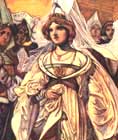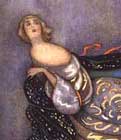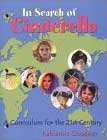
Cinderella:
345 Variants
by Marian
Roalfe Cox
SurLaLune's
Cinderella Area
SurLaLune Fairy Tales Main Page
38
Gronborg, O. L., Optegnelser pa Vendelbomal. Kobenhavn, 1884. P. 96. No. VI. (Oral; written down in the dialect of North Jutland.)
"STIFDATTEREN"
(The Step-daughter).
ABSTRACT
Ill-treated heroine (by step-mother and step-sisters)--Hearth abode--Dead mother help (at grave)--Magic dresses and equipage from tree which opens at command--Bagful of mist thrown before and behind heroine's chariot--Meeting-place (church)--Heroine sits in step-mother's pew; step-sisters are squeezed to make room for her--Threefold flight--Prince sees heroine vanish like a shooting star into mist--Lost shoe-- Shoe marriage test--Mutilated feet--Animal witness (crow)-- Happy marriage --(Villain Nemesis). Step-sisters grow yellow and grey with jealousy, and cry their eyes red, so that none court them.
TABULATION
(1) Heroine's fattier marries a widow with two wicked daughters. Heroine is cruelly treated, dressed in stepsisters' cast-off clothes, and made to live in the kitchen amongst the dirt and ashes.-- (2) She goes every Sunday evening to mother's grave, and weeps, saying there is none to whom she can confide her sorrow. Mother is moved in her grave;1 arises and comforts her, promises a happy future, and bids her ask leave to go to church next Sunday. If this be denied her, she must go to little service-tree2 (Sorbus aucuparia) in garden, knock at it thrice, and say, "Open my store; I am going to church."-- (3) Next Sunday, permission to go to church being denied her, heroine does as bidden by mother. The tree opens, and out drives a golden chariot- and-four, with men-servants; and there is a silk dress for her, and 'gold shoes. She steps into the chariot. They throw a bagful of mist before them and a bagful of mist behind them, that none may see whence they come or whither they go, and they hie to church. Heroine goes to stepmother's pew. To make room for her, stepsisters are squeezed up against the wall till they gape. Service over, heroine hastens to carriage; a bagful of mist is thrown before and behind, and she vanishes. Stepmother returns, boasting of her luck that the strange princess, discerning what kind of people she was amongst, should have sat down beside her and her daughters. Stepmother tries in vain to learn anything of unknown beauty.-- (4) Next Sunday church is crowded. King's son is there too, wanting to see beautiful princess, of whom everybody has been talking. Everything happens as on first Sunday. Prince rushes out, but all he sees is something like the long beam of a shooting-star through dense mist.-- (5) He is "elfshot"3 (bewitched) by the lovely girl, who next Sunday appeals again like a shooting-star, and hurries away as before after service. King's son pursues her, and puts his foot on one of her gold shoes, which she is obliged to leave behind as she vanishes, like a shouting-star, into mist.-- (6) He proclaims that he will wed whomsoever the shoe fits. All the girls try it on, some cutting heel and some toe. But on the churchyard-gate sits a crow, cawing:
"Cut heel and cut toe!
In the ashes sits the girl who has worn the golden shoe!"
(7) At last heroine, in her chariot, arrives through the mist like a shooting star, and puts her foot into the golden shoe, which fits it exactly. King's son steps into her chariot, and they drive to the palace. The wedding festivities last for fifteen days. Stepsisters are yellow and grey with vexation; and, since they cry their eyes red, nobody cares to court them.
1: Crying dead persons to life
was once a common superstition in Jutland. Traces of it are found in ballads
and sagas.
Return to place in text.
2: Few trees are found in the
severe climate of North Jutland. Hence this is probably a service-tree;
though the word also denotes a witch-tree.
Return to place in text.
3: "Elfshot" is used
of a very sudden love. Many sagas tell of elves enticing young men into
their fairy revels.
Return to place in text.
Cox, Marian Roalfe. Cinderella: Three Hundred and Forty-five Variants of Cinderella, Catskin, and Cap O' Rushes, abstracted and tabulated. London: David Nutt for the Folklore Society, 1893.
While the original text of this book is out of copyright, the special formatting and compilation available on SurLaLune Fairy Tales is copyrighted. Be aware that while the original content has been honored, page numbering, footnote numbering, redesigned charts, links, and other aspects are unique to this site's version of the text. Use at your own risk. For private and fair use educational purposes only.
©Heidi
Anne Heiner, SurLaLune Fairy Tales
E-mail: surlalune@aol.com
Page last updated February 1, 2006
www.surlalunefairytales.com










